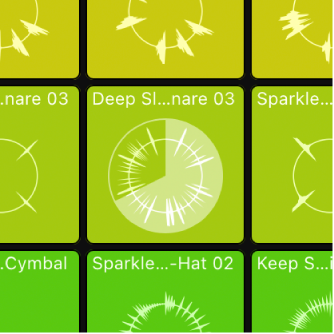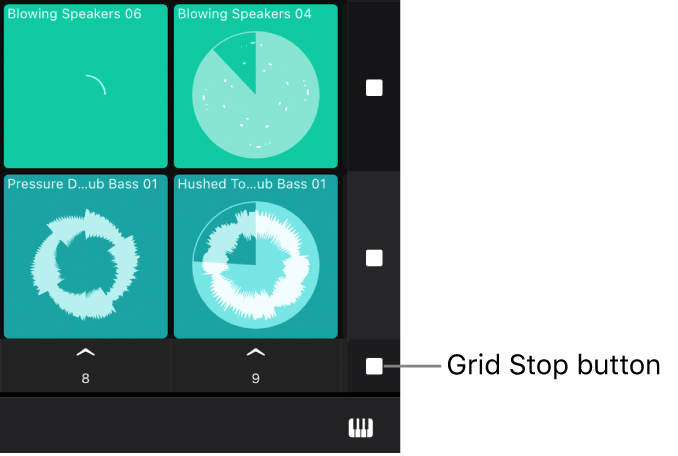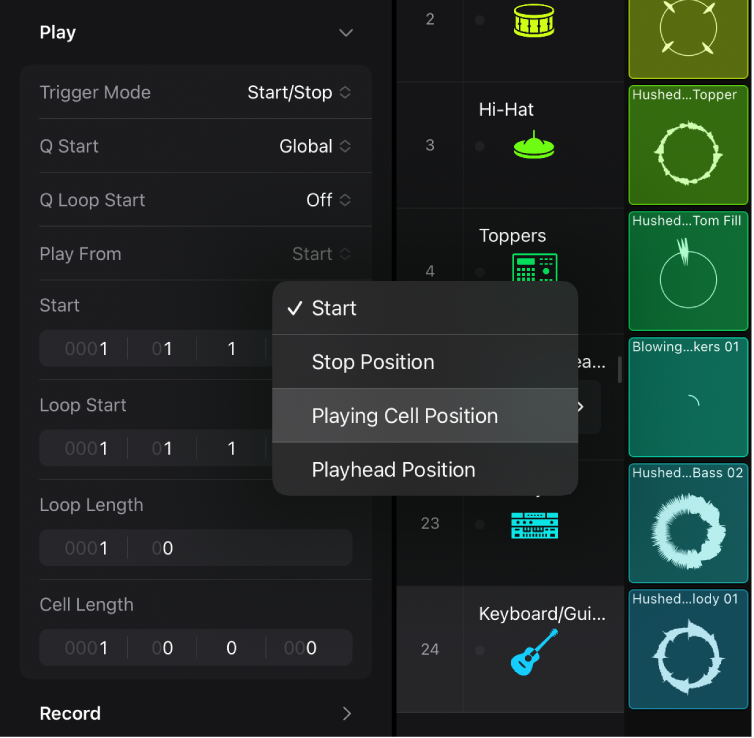Logic Pro User Guide for iPad
-
- What is Logic Pro?
- Working areas
- Work with function buttons
- Work with numeric values
-
- Intro to tracks
- Create tracks
- Create tracks using drag and drop
- Choose the default region type for a software instrument track
- Select tracks
- Duplicate tracks
- Reorder tracks
- Rename tracks
- Change track icons
- Change track colors
- Use the tuner on an audio track
- Show the output track in the Tracks area
- Delete tracks
- Edit track parameters
- Start a Logic Pro subscription
- How to get help
-
- Intro to recording
-
- Before recording software instruments
- Record software instruments
- Record additional software instrument takes
- Record to multiple software instrument tracks
- Record multiple MIDI devices to multiple tracks
- Record software instruments and audio simultaneously
- Merge software instrument recordings
- Spot erase software instrument recordings
- Replace software instrument recordings
- Capture your most recent MIDI performance
- Route MIDI internally to software instrument tracks
- Record with Low Latency Monitoring mode
- Use the metronome
- Use the count-in
-
- Intro to arranging
-
- Intro to regions
- Select regions
- Cut, copy, and paste regions
- Move regions
- Remove gaps between regions
- Delay region playback
- Trim regions
- Loop regions
- Repeat regions
- Mute regions
- Split and join regions
- Stretch regions
- Separate a MIDI region by note pitch
- Bounce regions in place
- Change the gain of audio regions
- Create regions in the Tracks area
- Convert a MIDI region to a Session Player region or a pattern region
- Rename regions
- Change the color of regions
- Delete regions
-
- Intro to chords
- Add and delete chords
- Select chords
- Cut, copy, and paste chords
- Move and resize chords
- Loop chords on the Chord track
- Edit chords
- Work with chord groups
- Use chord progressions
- Change the chord rhythm
- Choose which chords a Session Player region follows
- Analyze the key signature of a range of chords
- Create fades on audio regions
- Extract vocal and instrumental stems with Stem Splitter
- Access mixing functions using the Fader
-
- Intro to Step Sequencer
- Use Step Sequencer with Drum Machine Designer
- Record Step Sequencer patterns live
- Step record Step Sequencer patterns
- Load and save patterns
- Modify pattern playback
- Edit steps
- Edit rows
- Edit Step Sequencer pattern, row, and step settings in the inspector
- Customize Step Sequencer
-
- Effect plug-ins overview
-
- Instrument plug-ins overview
-
- ES2 overview
- Interface overview
-
- Modulation overview
- Use the Mod Pad
-
- Vector Envelope overview
- Use Vector Envelope points
- Use Vector Envelope solo and sustain points
- Set Vector Envelope segment times
- Vector Envelope XY pad controls
- Vector Envelope Actions menu
- Vector Envelope loop controls
- Vector Envelope point transition shapes
- Vector Envelope release phase behavior
- Use Vector Envelope time scaling
- Modulation source reference
- Via modulation source reference
-
- Sample Alchemy overview
- Interface overview
- Add source material
- Save a preset
- Edit mode
- Play modes
- Source overview
- Synthesis modes
- Granular controls
- Additive effects
- Additive effect controls
- Spectral effect
- Spectral effect controls
- Filter module
- Low, bandpass, and highpass filters
- Comb PM filter
- Downsampler filter
- FM filter
- Envelope generators
- Mod Matrix
- Modulation routing
- Motion mode
- Trim mode
- More menu
- Sampler
- Studio Piano
- Copyright
Start and stop Live Loops cells in Logic Pro for iPad
You can start and stop cells individually, or start and stop all the cells in a scene (a column in the grid) simultaneously. Only one cell can play on a track at any time. You can queue one or more cells in different scenes and trigger them to play together. While a cell is playing, a circular indicator in the middle of the cell shows the current playback position. If cell looping is turned off, a rectangular indicator shows the current playback position.

The point in time when a cell starts or stops is determined by the Quantize Start value. Quantize Start ensures that cells start at musically meaningful positions (beats or bars), so they are in sync with other cells and the project playhead position. You can change the Quantize Start value for the grid, for scenes, or for individual cells. Triggered cells flash to indicate that they are queued to start at the next quantize start point.
If you trigger a cell too late to start at the desired quantize start point, it starts playing at the next quantize start point. The cell will still be in sync with the project tempo, but it might lead to undesirable musical results, especially when cells are following a short Quantize Start value. Smart Pickup ensures that cells start immediately at the correct position, even when triggered slightly late. However, this can result in the beginnings of the cells being skipped in order to ensure that the cells are at the correct position when they start playing. In order to avoid this and ensure that cells start playing from the Start position set in the Cell inspector, turn Smart Pickup off and trigger cells with enough time before the upcoming quantize start point.
Cells in the Live Loops grid play at the project tempo. Apple Loops added to cells automatically play at the project tempo, as do any audio files containing tempo information. When you add an audio file without tempo information to a cell, Logic Pro analyzes the tempo of the audio file and adjusts the file to the project tempo. You can manually edit regions and automation in the Cell Editor.
By default, when a cell is playing on a track that contains regions in the Tracks area, the regions on that track are silent. You can change this behavior using the buttons in the Divider column. See How the Live Loops grid and Tracks area interact in Logic Pro for iPad.
Start cells
In Logic Pro, tap the Cell Trigger button ![]() in the Live Loops menu bar to turn on Cell Trigger mode, then do any of the following:
in the Live Loops menu bar to turn on Cell Trigger mode, then do any of the following:
Start a cell: Tap a cell.
Start all the cells in a scene: Tap a scene trigger
 .
.Start all selected cells: With a keyboard connected to your iPad, press Return.
Start all queued cells: Tap any queued cell.
Stop cells
In Logic Pro, do any of the following:
Stop playback of a cell:
Tap a playing cell.
Tap an empty cell on the same track as the one playing.
Stop playback of all cells at the next quantize start point:
Tap the Grid Stop button
 at the bottom of the Divider column.
at the bottom of the Divider column.
If you tap the Grid Stop button while cells are playing, the cells stop at the next quantize start point, but the project continues to play.
Tap the scene trigger
 below an empty scene.
below an empty scene.
Stop playback of all cells immediately: Tap the Stop button in the control bar.
Stop playback of all selected cells: With a keyboard connected to your iPad, press Return.
Queue cells and scenes
You can queue cells and scenes to start playing when project playback starts or when you want cells in different scenes to start at the same time. Playing cells are automatically queued when you stop project playback. When cells are queued, you can move the project playhead and trigger the queued cells at a different project position.
In Logic Pro, tap the Cell Queue button
 in the Live Loops menu bar, then do any of the following:
in the Live Loops menu bar, then do any of the following:Queue cells: Tap the cells you want to queue.
Queue a scene: Tap the scene trigger
 for the scene you want to queue.
for the scene you want to queue.
The queued cells start flashing.
Trigger queued cells
Do any of the following:
In Cell Queue mode, tap the Restart button
 in the lower right corner of the Live Loops grid.
in the lower right corner of the Live Loops grid.In Cell Trigger mode, tap any of the queued cells.
Tap the Play button to start project playback.
Set the Quantize Start value
You can set the Quantize Start value for the entire Live Loops grid, for a scene, or for individual cells, and change it while cells are playing. When you trigger a scene, all cells in the scene use the Quantize Start value for that scene. When you start or stop individual cells, each cell uses its own Quantize Start value.
To set the Quantize Start value for the Live Loops grid: Tap the Quantize Start pop-up menu near the upper-right corner of the grid, then choose a new value from the menu.
To set the Quantize Start value for a scene:
Tap the Cell Edit button
 in the Live Loops menu bar, then select one or more scenes.
in the Live Loops menu bar, then select one or more scenes.Tap the Inspector button
 to open the Scene inspector.
to open the Scene inspector.Tap the value for Q Start, then choose a new value from the menu.
To set the Quantize Start value for cells:
Tap the Cell Edit button
 in the Live Loops menu bar, then select one or more cells.
in the Live Loops menu bar, then select one or more cells.Tap the Inspector button
 to open the Cell inspector, then tap the Play disclosure arrow.
to open the Cell inspector, then tap the Play disclosure arrow.Tap the value for Q Start, then choose a new value from the menu.
In addition to bar and beat values, you can also choose the following Quantize Start values:
Global: The cell or scene follows the Quantize Start value of the grid. This is the default setting for cells and scenes, and probably the best choice for most situations.
Cell End: If another cell in the same row is playing, the triggered cell starts when the playing cell reaches the end of the loop.
Off: Cells start and stop when you tap them, regardless of the Quantize Start value. Note that this can lead to cells playing out of sync.
Turn on Smart Pickup
When Smart Pickup is on and you trigger cells or a scene slightly past the quantize start point, cells start immediately at the correct position instead of at the next quantize start point. This can result in the beginnings of the cells being skipped in order to ensure that the cells are at the correct position when they start playing.
Tap the Quantize Start pop-up menu near the upper-right corner of the grid, then choose Smart Pickup from the menu.
Set the trigger mode for cells
The trigger mode determines how a cell starts and stops when you tap it. Both actions are subject to the Quantize Start value. You can choose from three trigger modes:
Start/Stop: Cells start and stop playing when you tap them in Cell Trigger mode.
Momentary: Cells start playing at the next quantize start point when you touch them, and stop playing when you let go.
Retrigger: If a cell is playing and you tap it again, it starts playing from the beginning at the next quantize start point. Cells set to Retrigger can be stopped only by tapping another cell or empty cell in the same row, by tapping the progress indicator in the Divider column, or by stopping the entire grid.
Tap the Cell Edit button
 , then tap a cell to select it.
, then tap a cell to select it.Tap the Inspector button
 in the view control bar to open the Cell inspector.
in the view control bar to open the Cell inspector.In the Cell inspector, tap the Play disclosure arrow to view the Play settings.
Tap the Trigger Mode pop-up menu, then choose a trigger mode.
Change the start behavior of a cell
The Play From setting determines the start behavior of a cell. By default, cells start playing from the Start position. However, depending on the content and timing of your music, you can choose other start behavior settings to create interesting transitions between cells. You can choose from four settings:
Start: The cell starts at the position determined by the set Start position.
Stop Position: The cell starts playing from the point where it last stopped, similar to Play/Pause.
Playing Cell Position: If another cell in the same row is playing, the cell starts playing from the position where the first cell stops. Otherwise, the cell starts from the Start position.
Playhead Position: The cell starts from the position where it would be if it had been playing from the beginning of the project. Otherwise, the cell starts from the Start position.
In Logic Pro, tap the Cell Edit button
 in the Live Loops menu bar, then select one or more cells.
in the Live Loops menu bar, then select one or more cells.Tap the Inspector button
 in the view control bar to open the Cell inspector.
in the view control bar to open the Cell inspector.In the Cell inspector, tap the Play disclosure arrow.
Tap the Play From pop-up menu, then choose a setting.

Download this guide: PDF